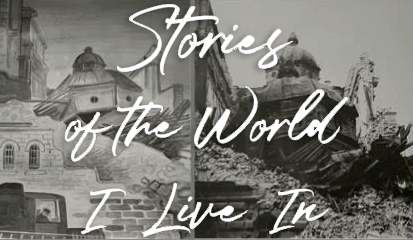Castle of My Memories
War Letters
Below are links to letters Victor wrote Kitty when he was drafted into the war.
Sadly, he was never able to mail his final letter that was written seven days before he passed away - it was found in his personal affects.
Historical Timeline of Victor's Life
Birth
Born in Troppau, (now Opava) Austria-Silesia. Father is a Colonel in the Austrian-Hungarian army. Education in a public elementary school; private lessons; then middle school in Troppau.
Education
Arts and Crafts school in Vienna. Studies with Professors Bohm, Loffler, and Schuffinsky. Later on, works on his own.
Joins Hagenbund
Member of Hagenbund in Vienna. Commissions and sale of his work make it possible for him to travel to Paris in the Fall of 1927. The German section of a Department in Prague grants him two travel Stipends: 1928 for Italy and Sicily; and 1929, for Greece. The Modern Museum (Moderne Galerie) in Prague buys two works on paper (both gouache technique). The Provincial Museum for Silesia buys two works on paper. In October, participates in exhibitions which show the new Austrian painting in foreign countries.
Paints Caroline Crosby
Designer for Obsterte he meets Caroline Crosby (Field) and paints two portraits.
Breakup
Breaks relation with Caroline Crosby.
Frescoe Exhibition
Paints frescoes for the Frescoe Exhibition at the Felsenreitschule in Salzburg, which will be shown later in Munich and Vienna.
Marries Ruth McVitty Plankch
In the spring marries the American Ruth McVitty Planckh on February 2 1932. Participates in a group exhibition at the Ferargil Gallery in New York. A pleasant success in every way.
Exhibits
Continues to exhibit and sell his work.
Italy
Trip to Italy. A lot of work is done during this trip, with stimulation and sketches for work at home: gouaches, watercolors, oil paintings, clay figures, Gobelin designs, as well as sketches for work in enamel.
Hagenbund Exhibition
Hagenbund Exhibition in Vienna includes a room of ten Planckh oil paintings.
Moscow
Trip to Moscow where he designs the “Russian Portfolio and a series of red pencil drawings. Designs a dozen petit-point ladies handbags for the company and supervises their production. These handbags will later be shown by themselves in a display window at Saks Fifth Avenue in New York. Makes the clay model for the sculpture “Cornelius”, which will be cast in bronze and also carved in stone.
Eastern United States
Travels back to the United States. Exhibition at the Present-Day Club of Princeton, New Jersey, and Boyer Gallery in Philadelphia. “Art in New Jersey” accepts the bronze head ”Edwarda”.
Western United States
Trip to the western United States. Return via Nebraska, Northern New York State, and Massachusetts. Has a rendezvous with “The 1938 Hurricane” on Cape Cod. “Western Portfolio” evolves: watercolors, gouaches, etchings, and oil paintings.
Return to Austria
Decides not to live in the United States and returns to Austria sells a farm in New Hope, Pa. Due to the serious illness of his wife, he lives for three months in Troppau and often moves into the hospital to be beside his wife. At Troppau he works on a series of the hospital and the city of Troppau. In the late spring, he moves to Vienna where he shares a studio with a sculptor, Professor Karl Stemolack. Works on sculpture figures under the guidance of Professor Stemolack.
Fuchsbau
Moves into his own house in Vienna with a studio for painting and sculpting. Works restlessly day and night. He receives his draft notice but is diagnosed with Osteomyelitis and is categorized as 4F by the army and is sent home to recuperate and get better. A decree by the Art Department of the National Socialist Tax Office says: “Either an artist earns money and pay taxes, or he has to be trained in a new profession such as road building or some such heavy duty work.” As a means of income, he writes and illustrates witty books: “The Apple of Knowledge,” “Animal Spelling Book,” and “Our Peter,” (a handbook for infant care and education, published by Dr. A Meier at the Wilhelm Frick Publishers of Vienna, Austria).
Death
Drafted in the German Army. After three months training as a truck driver, he is sent to Greece where he is ordered to document the Greek campaign in gouache. He falls sick with dysentery but finishes the 20 gouaches paintings. He dies of his sickness in hospital on June 11, 1941. The German Army sends the portfolio back to his widow. Buried in Army cemetery 11 Kilometers from Athens, Greece on the road to Piraeus.
DEATH NOTICE










